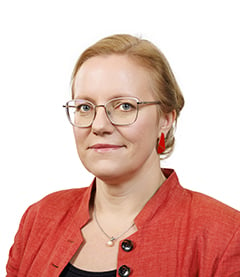-
Other audit services
We help clients with the application and use of foreign financial aid of EU and other funds and help prepare financial reports.
-
Audit calculator
The calculator will answer if the company's sales revenue, assets or number of employees exceed the limit of an inspection or audit.
-
Payroll and related services
We perform payroll accounting for companies whether they employ a few or hundreds of employees.
-
Tax accounting
Grant Thornton Baltic's experienced tax specialists support accountants and offer reasonable and practical solutions.
-
Reporting
We prepare annual reports in a timely manner. We help to prepare management reports and various mandatory reports.
-
Consolidation of financial statements
Our experienced accountants and advisors help you prepare consolidation tables and make the consolidation process more efficient.
-
Consultancy and temporary staff
Our experienced specialists advise on more complex accounting transactions, rectify poor historic accounting, and offer the temporary replacement of an accountant.
-
Outsourced CFO service
Our CFO service is suitable for companies of all sizes and in all industries. We offer services to our clients in the required amount and competences.
-
Assessment of accounting processes
We help companies to implement accounting practices that are in compliance with local and international standards.
-
Accounting services for small businesses
We offer affordable service for small businesses. We help organize processes as smartly and cost-effectively as possible.
-
Cryptocurrency accounting
We keep up with blockchain technology to serve and advise crypto companies. We are supported by a network of colleagues in 130 countries.
-
Trainings and seminars
Our accountants have experience in all matters related to accounting and reporting. We offer our clients professional training according to their needs.

-
Business advisory
We offer legal support to both start-ups and expanding companies, making sure that all legal steps are well thought out in detail.
-
Fintech advisory
Our specialists advise payment institutions, virtual currency service providers and financial institutions.
-
Corporate advisory
We advise on legal, tax and financial matters necessary for better management of the company's legal or organizational structure.
-
Transaction advisory
We provide advice in all aspects of the transaction process.
-
Legal due diligence
We thoroughly analyze the internal documents, legal relations, and business compliance of the company to be merged or acquired.
-
In-house lawyer service
The service is intended for entrepreneurs who are looking for a reliable partner to solve the company's day-to-day legal issues.
-
The contact person service
We offer a contact person service to Estonian companies with a board located abroad.
-
Training
We organize both public trainings and tailor made trainings ordered by clients on current legal and tax issues.
-
Whistleblower channel
At Grant Thornton Baltic, we believe that a well-designed and effective reporting channel is an efficient way of achieving trustworthiness.

-
Business model or strategy renewal
In order to be successful, every company, regardless of the size of the organization, must have a clear strategy, ie know where the whole team is heading.
-
Marketing and brand strategy; creation and updating of the client management system
We support you in updating your marketing and brand strategy and customer management system, so that you can adapt in this time of rapid changes.
-
Coaching and development support
A good organizational culture is like a trump card for a company. We guide you how to collect trump cards!
-
Digital services
Today, the question is not whether to digitize, but how to do it. We help you develop and implement smart digital solutions.
-
Sales organisation development
Our mission is to improve our customers' business results by choosing the right focuses and providing a clear and systematic path to a solution.
-
Business plan development
A good business plan is a guide and management tool for an entrepreneur, a source of information for financial institutions and potential investors to make financial decisions.
-
Due diligence
We perform due diligence so that investors can get a thorough overview of the company before the planned purchase transaction.
-
Mergers and acquisitions
We provide advice in all aspects of the transaction process.
-
Valuation services
We estimate the company's market value, asset value and other asset groups based on internationally accepted methodology.
-
Forensic expert services
Our experienced, nationally recognized forensic experts provide assessments in the economic and financial field.
-
Business plans and financial forecasts
The lack of planning and control of cash resources is the reason often given for the failure of many businesses. We help you prepare proper forecasts to reduce business risks.
-
Outsourced CFO service
Our CFO service is suitable for companies of all sizes and in all industries. We offer services to our clients in the required amount and competences.
-
Reorganization
Our experienced reorganizers offer ways to overcome the company's economic difficulties and restore liquidity in order to manage sustainably in the future.
-
Restructuring and reorganisation
We offer individual complete solutions for reorganizing the structure of companies.
-
Corporate taxation
We advise on all matters related to corporate taxation.
-
Value added tax and other indirect taxes
We have extensive knowledge in the field of VAT, excise duties and customs, both on the national and international level.
-
International taxation
We advise on foreign tax systems and international tax regulations, including the requirements of cross-border reporting.
-
Transfer pricing
We help plan and document all aspects of a company's transfer pricing strategy.
-
Taxation of transactions
We plan the tax consequences of a company's acquisition, transfer, refinancing, restructuring, and listing of bonds or shares.
-
Taxation of employees in cross-border operations
An employee of an Estonian company abroad and an employee of a foreign company in Estonia - we advise on tax rules.
-
Tax risk audit
We perform a risk audit that helps diagnose and limit tax risks and optimize tax obligations.
-
Representing the client in Tax Board
We prevent tax problems and ensure smooth communication with the Tax and Customs Board.
-
Taxation of private individuals
We advise individuals on personal income taxation issues and, represent the client in communication with the Tax and Customs Board.
-
Pan-Baltic tax system comparison
Our tax specialists have prepared a comparison of the tax systems of the Baltic countries regarding the taxation of companies and individuals.
-
Internal audit
We assist you in performing the internal audit function, performing internal audits and advisory work, evaluating governance, and conducting training.
-
Internal Audit in the Financial Services Sector
We provide internal audit services to financial sector companies. We can support the creation of an internal audit function already when applying for a sectoral activity license.
-
Audit of projects
We conduct audits of projects that have received European Union funds, state aid, foreign aid, or other grants.
-
Prevention of money laundering
We help to prepare a money laundering risk assessment and efficient anti-money laundering procedures, conduct internal audits and training.
-
Risk assessment and risk management
We advise you on conducting a risk assessment and setting up a risk management system.
-
Custom tasks
At the request of the client, we perform audits, inspections and analyzes with a specific purpose and scope.
-
External Quality Assessment of the Internal Audit Activity
We conduct an external evaluation of the quality of the internal audit or provide independent assurance on the self-assessment.
-
Whistleblowing and reporting misconduct
We can help build the whistleblowing system, from implementation, internal repairs and staff training to the creation of a reporting channel and case management.
-
Information security management
We provide you with an information security management service that will optimise resources, give you an overview of the security situation and ensure compliance with the legislation and standards.
-
Information security roadmap
We analyse your organisation to understand which standards or regulations apply to your activities, identify any gaps and make proposals to fix them.
-
Internal audit of information security
Our specialists help detect and correct information security deficiencies by verifying an organization's compliance with legislation and standards.
-
Third party management
Our specialists help reduce the risks associated with using services provided by third parties.
-
Information security training
We offer various training and awareness building programmes to ensure that all parties are well aware of the information security requirements, their responsibilities when choosing a service provider and their potential risks.
-
Digital Operational Resilience Act (DORA)
We will help you create a DORA implementation model that meets your company's needs and ensures that you meet the January 2025 deadline.

-
ESG advisory
We help solve issues related to the environment, social capital, employees, business model and good management practices.
-
ESG audit
Our auditors review and certify sustainability reports in line with international standards.
-
Sustainable investments
We help investors conduct analysis of companies they’re interested in, examining environmental topics, corporate social responsibility and good governance practices.
-
Sustainable tax behaviour
Our international taxation specialists define the concept of sustainable tax behaviour and offer services for sustainable tax practices.
-
ESG manager service
Your company doesn’t necessarily need an in-house ESG manager. This role can also be outsourced as a service.

-
Recruitment services – personnel search
We help fill positions in your company with competent and dedicated employees who help realize the company's strategic goals.
-
Recruitment support services
Support services help to determine whether the candidates match the company's expectations. The most used support services are candidate testing and evaluation.
-
Implementation of human resource management processes
We either assume a full control of the launch of processes related to HR management, or we are a supportive advisory partner for the HR manager.
-
Audit of HR management processes
We map the HR management processes and provide an overview of how to assess the health of the organization from the HR management perspective.
-
HR Documentation and Operating Model Advisory Services work
We support companies in setting up HR documentation and operational processes with a necessary quality.
-
Employee Surveys
We help to carry out goal-oriented and high-quality employee surveys. We analyse the results, make reports, and draw conclusions.
-
HR Management outsourcing
We offer both temporary and permanent/long-term HR manager services to companies.

-
Digital strategy
We help assess the digital maturity of your organization, create a strategy that matches your needs and capabilities, and develop key metrics.
-
Intelligent automation
We aid you in determining your business’ needs and opportunities, as well as model the business processes to provide the best user experience and efficiency.
-
Business Intelligence
Our team of experienced business analysts will help you get a grip on your data by mapping and structuring all the data available.
-
Cybersecurity
A proactive cyber strategy delivers you peace of mind, allowing you to focus on realising your company’s growth potential.
-
Innovation as a Service
On average, one in four projects fails and one in two needs changes. We help manage the innovation of your company's digital solutions!


The field of information security seems like a labyrinth full of abbreviations lately: NIS2, DORA, ISO 27001, E-ITS, SOC 2. Therefore, I will briefly advise on how to navigate information security regulations, standards, audits, and certifications.
Companies rightfully ask:
- What do we actually need to do?
- What is mandatory and what simply adds business value?
- What adds greater business value?
Below is a brief overview of the main information security requirements and frameworks currently most talked about in Estonia and the European Union.
NIS2: European Union Cybersecurity Directive
What is it?
A mandatory cybersecurity directive in the European Union that sets requirements for providers of critical and essential services. It needs to be transposed into local legislation to take effect. Estonia has not yet transposed NIS2, but there is a draft amendment to the Cybersecurity Act (KÜTS) that plans to do so.
Who does it apply to?
The public sector and private sector companies operating in areas such as energy, healthcare, cloud services, digital infrastructure, etc. The exact information on who these requirements will apply to in Estonia will be finalized after the amendment of KÜTS.
Is it mandatory?
Yes, for institutions and companies listed in the Cybersecurity Act, compliance is mandatory. However, it is important to remember that NIS2 does not directly apply to Estonian companies but through KÜTS.
Is an audit required?
Mostly yes. In addition, the Information System Authority (RIA) conducts supervision, meaning it can also audit, inspect, and request information.
Why is the answer mostly yes? Because it is up to the member state to decide. In Estonia, there are two options for complying with NIS2 requirements:
- Implement the Estonian information security standard E-ITS and audit it. Micro-enterprises are exempt from the audit obligation.
- Implement the information security management standard ISO/IEC 27001 and submit the certificate to RIA. The certificate must show that the scope of ISO 27001 covers the scope of E-ITS, i.e., all business processes necessary for providing essential/important services in the sense of NIS2/KÜTS.
Result: Compliance with requirements that must be demonstrable. If the requirements are not met, fines and injunctions may follow.
DORA: Digital Operational Resilience in the Financial Sector
What is it?
A European Union regulation that governs the assurance of digital operational resilience in the financial sector. Read more here.
Who does it apply to?
Banks, insurers, investment firms, payment service providers, and even some ICT service providers to the financial sector (e.g., cloud service providers).
Is it mandatory?
Yes.
Is an audit required?
DORA does not explicitly require an audit. However, supervision can be conducted by the Financial Supervision Authority and other supervisory authorities. Depending on the company's role and size, DORA may require technical resilience tests (e.g., threat-led penetration testing) and documented assessments by third parties.
Note! For companies providing information and communication technology services to the financial sector, the fact that their client must comply with DORA requirements may mean the need to demonstrate their own compliance. Independent audits and tests, as well as issued reports and/or certificates (e.g., ISO 27001, SOC 2, penetration tests), help in demonstrating compliance.
Result: Compliance with requirements that must be demonstrable.
If the requirements are not met, fines and injunctions may follow.
E-ITS: Estonian Information Security Standard
What is it?
A national standard in Estonia that sets requirements for information security.
Who does it apply to?
Mainly to the public sector and providers of services essential for the functioning of society (healthcare, communications, supply of medicines and fuel, etc.).
Is it mandatory?
Yes. The obligation to implement E-ITS is replaced only by the submission of an ISO 27001 certificate (i.e., implementation and auditing of the standard). The certificate must show that the scope of ISO 27001 covers the scope of E-ITS, i.e., business processes necessary for providing essential/important services in the sense of NIS2/KÜTS.
Is an audit required?
Generally yes. Under the current Cybersecurity Act, E-ITS obligors who have an average of fewer than ten employees during the financial year and whose balance sheet total or annual turnover does not exceed 2 million euros (i.e., micro-enterprises) do not need to conduct an audit.
Result: Audit conclusion and report.
A certificate as such is not issued.
E-ITS is an Estonian standard, so it is not known outside.
ISO/IEC 27001: International Information Security Management System Standard
What is it?
An international standard that specifies requirements for an information security management system (ISMS). ISO 27001 is not a legal requirement but a voluntary standard that helps systematically manage information security. As a bonus, the ISO 27001 certificate is internationally recognized.
Who is it useful for?
All organizations that want to demonstrate security to clients or partners – especially in B2B and highly regulated sectors (e.g., finance, healthcare, IT services).
Is an audit required?
The standard can be applied as good practice without an audit, but if you want a certificate, you need to order an audit from an accredited certification body. The audit cycle is three years and includes the initial certification audit and two interim audits.
Result: An internationally recognized certificate that is usually valid for three years.
SOC 2: Service Provider Security Assessment
What is it?
SOC 2 (System and Organization Controls 2) is a security and compliance framework developed by the American Institute of Certified Public Accountants (AICPA). It is designed to assess how well an organization protects client data – especially when data is stored in the cloud or offered as a service (e.g., SaaS solution). The SOC 2 auditor assesses the service provider's compliance with trust principles (security, availability, confidentiality, etc.). The main goal of SOC 2 is to give clients and partners confidence that the company manages data securely and responsibly, has implemented control measures that ensure continuous privacy, availability, and confidentiality, and follows best practices for internal management and risk management.
Who is it useful for?
Common among companies offering SaaS solutions and service providers operating in the US market or serving global clients. The SOC 2 report includes a fairly detailed assessment of the company's security measures and their implementation, and many large companies require a SOC 2 audit from their partners.
Is an audit required?
Yes. The audit can be either Type 1 (point-in-time) or Type 2 (over six months to a year).
Result: The SOC 2 report (not a certificate) is a confidential document that proves that the service provider's systems meet the selected SOC audit criteria.
How to make a choice?
The world of information security may seem complex at first glance, full of different standards, regulations, audits, reports, and certificates. Navigation becomes easier when understanding each framework by its purpose, target audience, and outcome. Some – like NIS2 (KÜTS) and DORA – are legally binding and affect specific sectors. Others, like ISO 27001, SOC 2, or NIST, offer voluntary but widely accepted frameworks for demonstrating maturity and managing security risks.
Which is the most useful depends on the business sector, the nature and expectations of clients, the specifics and maturity level of the company. If you need more detailed advice or help in deciding what applies or suits your company, contact Grant Thornton Baltic.
If you have similar challenges and questions, please contact our specialists.






